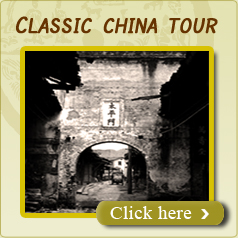Millennium city park

Have you ever dreamed of going back in time to Northern Song Dynasty (960-1127) in China and savor the prosperity and culture of those years? If so, come to Millennium City Park (also called Qingming Riverside Landscape Garden) located in the old city of Kaifeng (the former Bianjing) in Henan Province. Find yourself in the spectacular scenery there and you are sure to realize that dream.
This park was constructed according to the famous painting Going Upriver for Qingming Festival by the Northern Song Dynasty painter Zhang Zeduan. It reproduced everything painted in the painting by the ratio of one to one. So it is a large-scale historical and cultural theme park following the Song Dynasty style. It covers an area of 600 mu (about 98 acres), and the construction area is more than 30,000 square meters (about 7.4 acres). The built area consists of several architectural complexes which are re-creations based on the famous twelfth century painting by Zhang Zeduan of 'The Qingming Festival by the Riverside. This picture is a painted scroll which is 525 cm (about 17 feet) in length and 25.5 cm (9.5 inches) in width depicting life along Bian River during the Qingming Festival. The scenes in this painting are highly detailed and the spectacle is magnificent.
In the park, everything is arranged in accordance with Gonging Upriver for Qingming Festival and follows Song Dynasty's style. So tourists can see what was the popular in the society at that time, such as tearooms, taverns, pawnshops, china workshop, Spring Festival pictures workshop, folk fun games, vaudeville, pan drum, fortune-telling, gambling, cock fight,etc. Of course, you can wear Song Dynasty's clothes and take Song Dynasty's coin to enjoy the customs of that time.
When you enter the Millennium City Park, a statue which is 16 meters (about 52 feet) tall comes into view. This figure is none other than the artist Zhang Zeduan, who holds his famous drawing of 'The Qingming Festival by the Riverside'. Now we can find these scenic spots such as City Gate Tower, Rainbow Bridge, distinctive shops and others which are re-created in the Park according to the scenes in the painting.
Let's first visit the imperial garden of the park. All the palaces and gardens have been carefully arranged. Standing inside the gardens and visible from outside, are the pavilion and the pagoda while in the distance a waterfall comes into view. Among these a majestic pavilion of 31.99 meters (about 105 feet) will draw our attention. From its appearance, you will expect it to have four floors but actually there are another three floors hidden inside. It is so tall and seems to be able to touch the clouds. This is how it got the name of Fuyun (whisking the cloud) Pavilion. It was also the place where important royal documents and traditional Chinese painting and books are stored during the Song Dynasty.
Another scenic spot called Rainbow Bridge is a well-known feature in the Park. It is a replica of one of the ten ancient timber bridges. The bridge is 5 meters (about 16 feet) high. The first bridge was built in 1050, and reconstructed in 1998. Four 9 meter (about 29 feet) high columns, two at either end of the bridge, replicate the poles that were weather vanes at the time of the Song Dynasty. A white crane sits on a disk at the top of each column and they turn to face into the wind, indicating its direction.
The whole landscape in Millennium City Park reflects an eternal theme of harmony between man and nature. It is a place where you can relax and gain inspiration.





